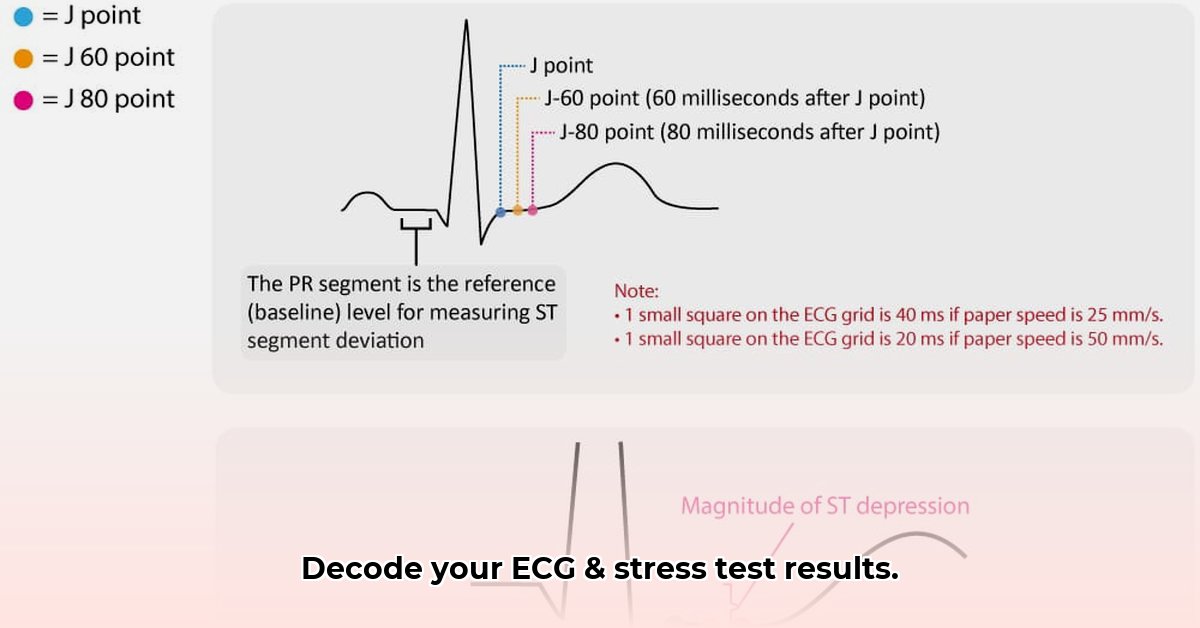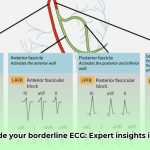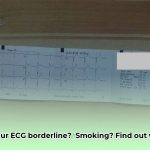Confused by your heart test results? Getting a borderline ECG during an exercise stress test can be really confusing, leaving you and your doctor with more questions than answers. This guide will help clear things up. We’ll explain what a borderline ECG means, walk you through the process of interpreting the test, and show you how doctors use this information to figure out your heart health. We’ll cover common mistakes to avoid and offer simple ways to understand things better, whether you’re a doctor or just want to understand your own test results. For more information on further testing, see this helpful guide on borderline ECG testing. Let’s make sense of those borderline ECGs together!
Borderline ECG and Exercise Stress Test: Decoding the Results
Let’s talk about your heart health and those sometimes confusing test results. If you’ve had a borderline ECG and an exercise stress test, you’re likely wondering what it all means. This guide aims to demystify the process and help you understand your results.
Understanding the Exercise Stress Test: Unveiling Heart Function
Think of an exercise stress test (EST) as a mini-marathon for your heart. You’ll walk or cycle on a treadmill or stationary bike, gradually increasing the intensity. While you’re exercising, we monitor your heart’s electrical activity (that’s the ECG), blood pressure, and any symptoms you might experience. This gives us a picture of how your heart performs under pressure – because heart issues sometimes only become apparent when your heart’s working hard. It’s like a stress test for your ticker! Why is this test so crucial in assessing cardiac health?
The exercise stress test, also known as a treadmill test or exercise ECG, is a non-invasive diagnostic tool used to assess the heart’s response to physical exertion. It is a valuable tool for detecting coronary artery disease (CAD), evaluating exercise capacity, and assessing the effectiveness of cardiac treatments. During the test, the patient walks on a treadmill or cycles on a stationary bike while heart rate, blood pressure, and ECG are continuously monitored. The intensity of the exercise is gradually increased until the patient reaches a target heart rate or experiences symptoms such as chest pain, shortness of breath, or fatigue.
Why bother? Because some heart problems only show up when your heart is exerting itself. The EST helps us detect these “hidden” problems. The exercise stress test boasts high specificity, making it valuable to rule out disease, especially with a negative result. A negative result on an exercise stress test typically indicates that there is no significant blockage in the coronary arteries and that the heart is functioning normally under stress. However, it’s important to note that a negative result does not completely rule out the possibility of heart disease, as some blockages may not be severe enough to cause symptoms during exercise.
Why that Borderline ECG Matters: Implications on Cardiovascular Health
Sometimes, a resting ECG—the snapshot of your heart’s electrical activity while you’re at rest—shows something a little unusual. We call this a “borderline” ECG. This doesn’t automatically mean something’s seriously wrong; it just means there are some minor irregularities that need further investigation. That’s where the exercise stress test plays a vital role. It helps us determine if those seemingly minor quirks in your resting ECG are actually a sign of a larger issue or just a harmless variation.
A borderline ECG can manifest in several ways, including minor ST-segment or T-wave abnormalities, slight axis deviations, or the presence of premature beats. These findings may be normal variants in some individuals, but they can also be indicative of underlying cardiac conditions such as ischemia, electrolyte imbalances, or structural heart disease.
Putting It All Together: Factors Influencing ECG & Exercise Test Results
Understanding the results isn’t simply about looking at the ECG alone. We consider a whole bunch of things:
- ECG Changes During Exercise: This is the most crucial part. The doctor(s) will carefully look at how your ECG tracing changes as you exercise. They’ll pay especially close attention to something called ST-segment depression. If present, it might suggest reduced blood flow to your heart during exertion. How much depression? At what point during the test did it occur? These details are essential to understanding the bigger picture.
- Your Symptoms: Did you feel anything unusual during the test? Chest pain (even mild), shortness of breath, lightheadedness—all of this information is valuable in interpreting the results. Even if these symptoms were subtle, they need to be considered.
- Blood Pressure and Heart Rate: How your blood pressure and heart rate respond to exercise is important. An unusual response, either too high or too low, could signal a potential problem. Everyone’s response varies, so these results are interpreted in relation to your individual baseline data.
How Long You Exercised: Did you manage to go the whole duration of the test, or did you need to stop early? Your “exercise capacity”, or how long you could exercise before stopping, adds another piece to the puzzle.
Reason for Test Termination: If the test ended sooner than expected—due to fatigue, pain, or other reasons—this is carefully noted and analyzed.
In short, combining your borderline ECG results with the findings from the exercise test gives doctors a much clearer picture. It helps determine whether your unusual resting ECG reflects a truly healthy heart with a small anomaly, or if it’s a clue hinting at something that requires further investigation. The exercise stress test evaluates several crucial parameters, including:
- ST-Segment Changes: ST-segment depression or elevation during exercise can indicate myocardial ischemia, a condition in which the heart muscle isn’t receiving enough blood flow. The morphology (shape) and magnitude of ST-segment changes are carefully analyzed to determine the likelihood of coronary artery disease. A horizontal or downsloping ST-segment depression of 1 mm or more is generally considered a positive result, indicating a high probability of ischemia. Upsloping ST-segment depression is less specific and requires careful interpretation in the context of other findings.
- Heart Rate Response: The heart’s ability to increase its rate in response to exercise is an important indicator of cardiovascular health. Chronotropic incompetence, the inability to achieve the target heart rate during exercise, may suggest underlying heart disease or conduction abnormalities.
- Blood Pressure Response: A normal blood pressure response to exercise is a gradual increase in systolic blood pressure and little or no change in diastolic blood pressure. An exaggerated rise in blood pressure, a drop in blood pressure, or failure of blood pressure to rise may indicate underlying cardiovascular abnormalities.
- Exercise Capacity: Exercise capacity, measured in metabolic equivalents (METs), reflects an individual’s overall fitness level and ability to perform physical activity. A low exercise capacity may indicate underlying heart disease, pulmonary disease, or musculoskeletal limitations.
- Symptoms: The presence of symptoms such as chest pain, shortness of breath, dizziness, or fatigue during exercise can provide valuable clues about the underlying cause of the borderline ECG. These symptoms are carefully documented and correlated with the ECG findings to arrive at an accurate diagnosis.
Decoding Your Combined Results: Interpreting the Diagnostic Outcome
After evaluating all these factors, your doctor will classify your results into one of a few categories:
- Normal: Great news! Your heart handled the stress well, and your ECG showed no significant abnormalities.
- Positive: This suggests potential heart problems. The test showed worrisome changes, such as notable ST-segment depression or notable symptoms during the exercise portion. Further tests, possibly a coronary angiogram (a type of heart catheterization), are usually recommended to get a more detailed evaluation.
- Non-diagnostic: Sometimes the test doesn’t give a clear-cut answer. Perhaps there were technical issues, or the results were ambiguous. In these cases, your doctor will likely recommend additional tests or a repeat stress test.
- Borderline: This is the category directly related to your initial ECG findings and how the results changed during exercise. The stress test clarifies whether the initial borderline ECG merely reflects a minor variation or is indeed pointing towards an underlying heart condition.
The key thing to remember is that the “borderline” category is a signal for further investigation. It’s not a diagnosis in itself. It simply implies that more analysis is needed.
What Happens Next? Navigating Post-Test Recommendations
Your doctor will discuss the results with you in detail, explaining what it all means in terms of your heart health. They’ll help you understand the implications, and based on the results, might recommend additional tests or treatments. This could involve lifestyle changes (like diet and exercise), medication, or more advanced imaging tests.
Based on the results of the exercise stress test and other clinical information, the doctor may recommend one or more of the following:
- Lifestyle Modifications: Lifestyle changes such as adopting a heart-healthy diet, engaging in regular physical activity, quitting smoking, and managing stress can help improve cardiovascular health and reduce the risk of heart disease.
- Medications: Medications such as antianginal drugs, beta-blockers, ACE inhibitors, or statins may be prescribed to manage symptoms, control blood pressure and cholesterol levels, and reduce the risk of future cardiac events.
- Further Diagnostic Testing: Further diagnostic tests such as echocardiography, cardiac CT angiography, or coronary angiography may be recommended to obtain more detailed information about the heart’s structure and function and to assess the presence and severity of coronary artery disease.
- Interventional Procedures: In some cases, interventional procedures such as angioplasty and stenting or coronary artery bypass surgery may be necessary to open blocked coronary arteries and restore blood flow to the heart muscle.
It’s crucial to remember
- How Much Do Wellness Programs Cost Businesses To Offer? - December 16, 2025
- Wellness Fair Ideas for Work to Boost Employee Wellbeing - December 15, 2025
- Affordable Employee Wellness Fair Ideas for Any Budget - December 14, 2025
















